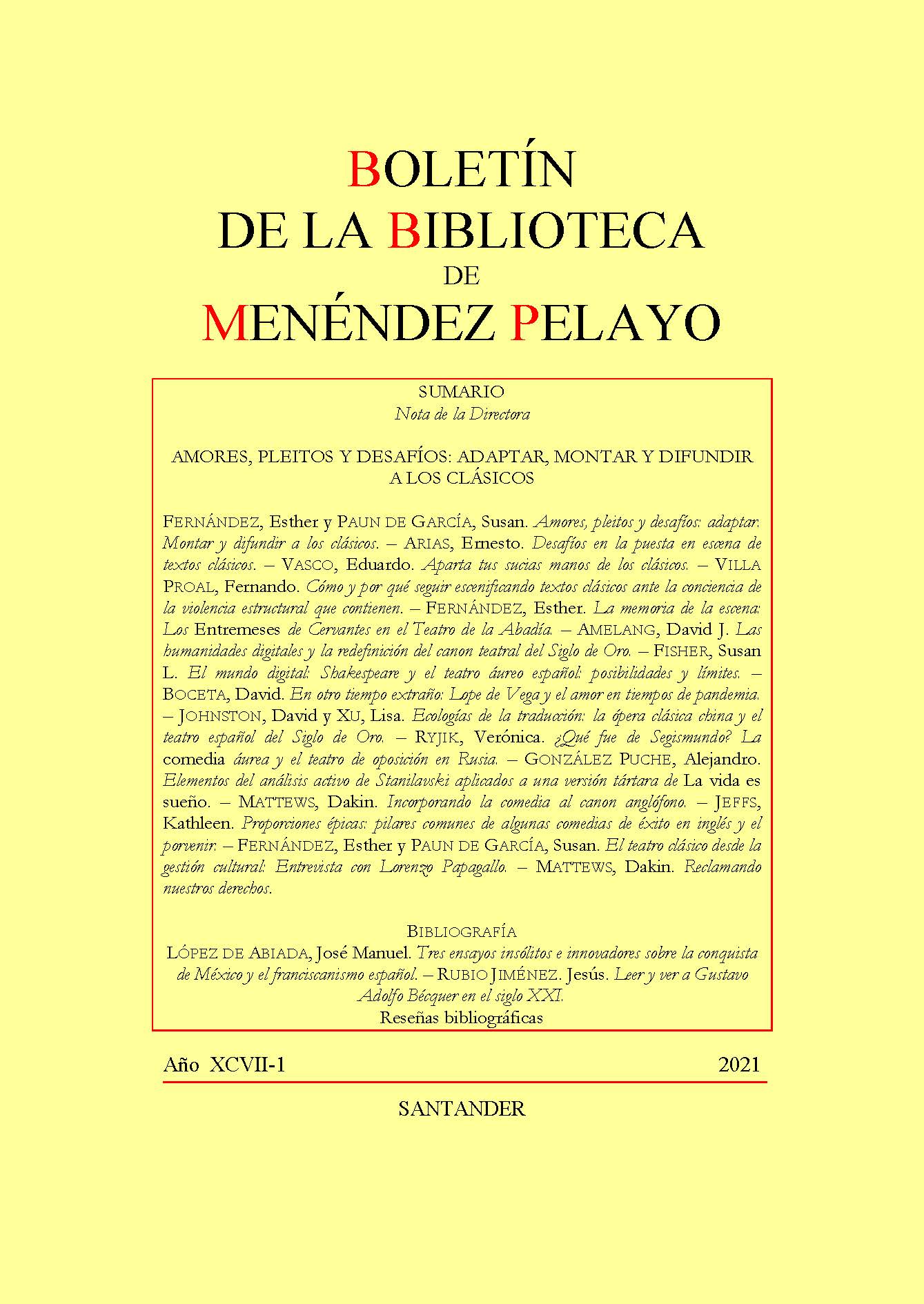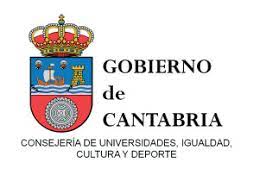La memoria de la escena: los entremeses de Cervantes en el Teatro de la Abadía
DOI:
https://doi.org/10.55422/bbmp.265Palabras clave:
Cervantes, Teatro de la Abadía, Entremeses, Ernesto Arias, José Luis GómezResumen
Los entremeses de Cervantes se han convertido en una marca de identidad del icónico teatro madrileño de la Abadía. En 1995 José Luis Gómez dirigió La cueva de Salamanca, El retablo de las maravillas y El viejo celoso. En el 2015, el mismo director los repone con motivo del veinte aniversario de La Abadía. Más adelante, en el 2017, Ernesto Arias continúa esta saga cervantina en el mismo teatro, pero esta vez con el montaje de Dos nuevos entremeses “nunca representados” (La guarda cuidadosa, El rufián viudo llamado Trampagos). Este artículo estudia cómo se puede llegar a crear una continuidad artística desde la escena tomando como caso de estudio la puesta en escena de Gómez de 1995. Por un lado, se reflexiona en cómo y por qué un montaje específico puede llegar a convertirse en un fenómeno teatral y perpetuarse a lo largo de veintidós años en la memoria cultural de un espacio teatral. Por otro, se evalúa hasta qué punto La Abadía ha influido en la creación, continuidad y renovación de este fenómeno teatral.
Descargas
Publication Facts
Reviewer profiles N/D
Author statements
Indexado: {$indexList}
- Academic society
- Sociedad Menéndez Pelayo
- Editora:
- Sociedad Menéndez Pelayo
Estadísticas globales ℹ️
|
142
Visualizaciones
|
169
Descargas
|
|
311
Total
|
|
Citas
BREDEN, Simon David. (2014). The Creative Process of Els Joglars and Teatro de la Abadía: Beyond the Playwright. Woodbridge. Tamesis.
BROUWER, Ronald, ed. (2005). ‘Nada es como es, sino como se recuerda’. Teatro de la Abadía 1995-2005. Madrid. Teatro de la Abadía.
CANONICA, Elvezio. (2011). «Los Entremeses de Cervantes como Sistema». Anales Cervantinos XLIII. 221-242. DOI: https://doi.org/10.3989/anacervantinos.2011.009
CARLSON, Marvin. (1989). Places of Performance: The Semiotics of Theatre Architecture. Ithaca. Cornell University Press.
CERVANTES, Miguel de. (1987). «Prólogo al lector». Entremeses. Ed. Nicholas Spadaccini. Madrid. Cátedra. 91-94.
CUADROS, Carlos. (1994). «José Luis Gómez inaugura La Abadía. Un centro para la formación y la exhibición». Primer Acto 254. 16-19.Dossier de Prensa. (2017). Dos nuevos entremeses «nunca Representados». Miguel de Cervantes. Madrid. Teatro de La Abadía.
FERNÁNDEZ, Esther. (2018). «Entrevista con Ernesto Arias: el arte de hacer vivir a los clásicos». Don Galán. Revista de investigación teatral 8. 71-74. http://teatro.es/contenidos/donGalan/donGalanNum8/pagina.php?vol=8&doc=2_3&pag=2)
GARCÍA AGUILAR, Ignacio, Luis GÓMEZ CANSECO, y Adrián J. SÁEZ. (2016). El teatro de Miguel de Cervantes. Madrid. Visor Libros.
GARCÍA GARZÓN, Juan Ignacio. (2015). «Bajo el árbol de Cervantes». ABC. [no hay páginas]
GÓMEZ, José Luis. (2014). Breviario de teatro para espectadores activos. Discurso leído el día 16 de enero de 2014 en su recepción pública por elexcmo. Sr. D. José Luis Gómez y contestación del Excmo. Sr. D. Juan Luis Cebrián. Madrid. Real Academia Española. 9-45.
GONZÁLEZ, Antonio, B. (2004). «Teatro y gestión: El Teatro de la Abadía de Madrid». En Teatro y Sociedad en la España actual. Eds. Wilfred Floeck and María Francisca Vilches de Frutos. Madrid. Iberoamericana. 31-50. DOI: https://doi.org/10.31819/9783964565327-004
GOYTISOLO, Juan. (1996). Programa de mano de Entremeses. Teatro de La Abadía.Guía Didáctica. (2017). Dos nuevos entremeses «nunca representados». Miguel de Cervantes. Madrid. Teatro de La Abadía.Guía didáctica. (2015). Entremeses. Miguel de Cervantes. Madrid. Teatro de La Abadía.
MORILLO, María Dolores. (2018). «‘Ya soy mío’: Escarramán y la autonomía del arte en El rufián viudo llamado Trampagos.» Cervantes 38.2. 161-201. DOI: https://doi.org/10.1353/cer.2018.0023
PÉREZ DE LEÓN, Vicente. (2005). Tablas destempladas: Los entremeses de Cervantes a examen. Alcalá de Henares. Centro de Estudios Cervantinos.Teatro de la Abadía. (2000). 5 años de placer inteligente. Madrid. Fundación Teatro de la Abadía.
VALLEJO, Javier. (2014). «Volver sobre los propios pasos». El País (Cultura). https://elpais.com/cultura/2014/12/23/actualidad/1419338442 _680395.html
Descargas
Publicado
Cómo citar
Número
Sección
Licencia
Derechos de autor 2022 Esther Fernández

Esta obra está bajo una licencia internacional Creative Commons Atribución-NoComercial 4.0.







